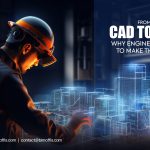Building systems require high quality and easy to understand design drawings. Construction experts use MEP (building systems) drawings and HVAC (heating ventilation and air conditioning) drawings to design projects. These types of drawings work together but have specific functions. Understanding these two types acts as the foundation for effective project completion.
What Are MEP Drawings?
MEP drawings show how engineers will build mechanical, electrical, and plumbing systems in a structure. These drawings are comprehensive and encompass:
Mechanical Systems: The technical sheet displays all elements of mechanical systems including heating, ventilation and air conditioning plus the pipes and ducts that support them.
Electrical Systems: The plan shows how electrical power flows with lighting installations while displaying fire protection and communication network positioning.
Plumbing Systems: The designs show how water moves from supply to drainage while connecting all pipes.
Purpose: MEP drawings display all building systems from one view to help designers coordinate work without design errors.
What Are HVAC Drawings?
HVAC drawings within MEP design documents show all aspects of heating ventilation and cooling systems as a special subject area. They include:
Duct Layouts: These drawings show how air flows from supply to return and exhaust ducts.
Equipment Placement: Fast food giants like McDonald’s and Burger King use HVAC drawings to show where their main heat systems are placed.
Piping Systems: The drawings show where to install refrigerant lines plus condensate drains and heating water systems.
Purpose: HVAC drawings help building owners reach environmental comfort limits while saving energy.
Key Differences Between MEP and HVAC Drawings:
Scope of Work
MEP Drawings present complete documentation of their technical scopes across all building systems. HVAC Drawings focus solely on designing how buildings control heat and manage their airflow.
Level of Detail
MEP drawings show total system arrangements at a basic level with how items connect to other systems. HVAC drawings deliver specialized plans about how building systems heat, cool, and ventilate areas.
The Different Specialist Groups Work Together
MEP drawings are created to align all system elements so their components do not overlap. HVAC drawings show how mechanical systems should be arranged but they depend on MEP for electrical and plumbing connections.
Stakeholders Involved
Both MEP Engineers and coordinators make MEP drawings. Mechanical engineers and HVAC design experts are responsible for making HVAC drawings.
Customization
The MEP drawing system matches building design features. HVAC design plans adjust to match the required heating and cooling capacities as well as airflow control specifications.
Why the Distinction Matters
Learning about these differences leads to better project management results. Although MEP drawings show building systems as a whole HVAC drawings are essential because they help design and place climate control components.
Using MEP drawings builders can spot potential conflicts like when an HVAC duct crosses an electrical conduit and fix them before work starts. Planned coordination between building systems increases project budget savings and meets all necessary construction requirements.
Conclusion
Modern construction needs MEP and HVAC drawings that work together. The collaboration between these drawings produces interconnected building systems that produce effective space utilization and top-notch user experiences. Understanding these differences helps contractors architects and project managers deliver their projects as intended.
Newsletter: The Most Important BIM Services for San Francisco’s Construction Industry in 2025
Building Information Modeling leads San Francisco’s construction development as it speeds up industry progress today. The need for project efficiency sustainability and affordable project delivery stays incredibly strong as we reach 2025. What specific BIM services drive the industry forward today?
1. Digital Twin Technology Helps Cities Make Better Decisions
Digital twins change how San Francisco manages buildings as its smart city progress makes the city a leader in technology. Digital models that work in real time enable development teams to spot potential failures and find ways to use energy better while boosting building performance before problems happen.
2. BIM Scanning Detects and Helps Preserve Old Structures During Modernization Tasks
With both historical and modern architecture in one city area Scan-to-BIM becomes an essential service. By scanning building construction details laser technology lets architects and engineers keep the original design in place while upgrading them for Pacific Heights and Financial District buildings.
3. BIM-Integrated Sustainability & Net-Zero Construction
California’s strict environmental regulations are pushing firms toward BIM-driven energy analysis and net-zero construction strategies. With BIM, developers can simulate energy performance, optimize material usage, and ensure compliance with Title 24 energy codes, reducing the carbon footprint of new developments.
4. 4D & 5D BIM for Real-Time Cost & Schedule Optimization
With increasing project complexities, 4D BIM (time simulation) and 5D BIM (cost estimation) are becoming indispensable. Contractors leverage these tools to predict potential delays, manage resources efficiently, and maintain project budgets—a game-changer for large-scale commercial and infrastructure projects.
5. Clash Detection & Coordination for Large-Scale Developments
With SF’s growing demand for mixed-use high-rises and transit-oriented developments, clash detection in BIM ensures seamless coordination between MEP, structural, and architectural elements. Reducing conflicts before construction begins translates to fewer change orders, lower costs, and faster project delivery.
What’s Next for BIM in San Francisco?
Is your firm ready for the BIM revolution in 2025? Let’s discuss how these solutions can drive efficiency and innovation in your next project.
📩 [Contact Us Today] to learn more.






